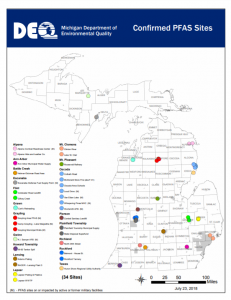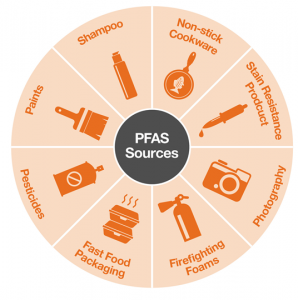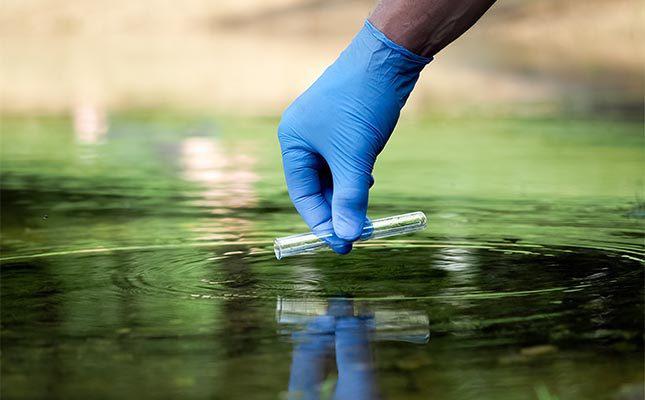
State says it’s a sign its programs are working
On Sunday, July 29th, the State of Michigan declared two townships in Kalamazoo County a state of emergency due to PFAS contamination.
Michigan Department of Health and Human Services Communications Director Angela Minicuci tells Great Lakes Now the results of recent state tests came in at 1600 parts per trillion of PFAS in both townships’ drinking water. The EPA health advisory level is 70 parts per trillion (ppt.)
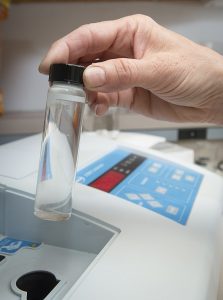
Water testing at a treatment facility, Photo by Lance Cheung, USDA via wikimedia
The amount of PFAS discovered in both communities is more than 20 times higher than the EPA advisory level.
Parchment is located just a few miles northeast of Kalamazoo, but the state says Kalamazoo’s water does not have unsafe levels of PFAS.
Minicuci says the tests are the result of statewide testing mandated by Michigan Governor Rick Snyder. “The state has a PFAS action response team created by the Governor back in November. We are testing all municipal water systems.”
She says when results came in last week, the state immediately told the more than 3000 residents of Parchment and Cooper townships to stop drinking their water, and the state opened up emergency centers so citizens could pick up supplies of bottled drinking water.
Minicuci says, “PFAS are associated with an increased risk of some types of cancer including prostate and cervical cancer. There are also associations with thyroid conditions.” She says more research on what happens when humans ingest PFAS needs to be done, and not all PFAS are bad.
“You need an alternative source of water”
She says, “We recommend not drinking the water but it is safe to bathe in and wash your hands. Touching the water is not a problem. We recommend not using it for drinking, for baby formula, or rinsing your fruits and vegetables. Those ingestion routes are what we are concerned about. You need an alternative source of water.”
Minicuci says officials are removing the water from both townships’ municipal systems and flushing it out. Both townships will then use the city of Kalamazoo’s water supply, and the city of Kalamazoo will continue flushing out Parchment and Cooper township’s water supply system until test results come back that show the PFAS levels are safe.

Water Pickup location, Photo by Lance Cheung, USDA via flickr
Residents of both townships where PFAS contamination was discovered are being told to pick up bottled water at Parchment High School. A hotline number which works from 8 am to 5pm has been set up for residents to use: the number is (269) 373-5346.
Minicuci says Parchment and Cooper Townships are the only communities in Michigan – so far – where high levels of PFAS have been detected in municipal water systems. However, she says additional testing is being done on private residential wells.
The state of emergency declaration in parts of Kalamazoo County came just a few days after new revelations of PFAS contamination from Michigan’s Selfridge air base into Lake St. Clair and the Clinton River were revealed, and other suspected sites from Otsego County to Saginaw to Western Michigan to the Upper Peninsula were being examined by State Inspectors.
The Michigan Department of Environmental Quality says there are now 35 confirmed sites in the state that are contaminated with PFAS. And more than 11,000 sites have the potential to be contaminated with PFAS-containing materials or waste.
The situation sounds dire to some Michigan residents and environmentalists. But Michigan’s Department of Environmental Quality (MDEQ) sees this state of emergency declaration in the two Kalamazoo County townships as well as the determination of thousands of potential PFAS sites as a sign of success.
MDEQ spokesperson Scott Dean tells Great Lakes Now, “Michigan’s quick and proactive response to the emerging issue of PFAS contamination has resulted in an additional 3,000 Michiganders being protected from contaminated drinking water.”
PFAS is the acronym for Per and polyfluoroalkyl substances – it’s a group of man-made chemicals that includes PFOA, PFOS, GenX, and other chemicals.
A U.S. Environmental Protection Agency (EPA) report states, “PFAS have been manufactured and used in a variety of industries around the globe, including in the United States since the 1940s. PFOA and PFOS have been the most extensively produced and studied of these chemicals. Both chemicals are very persistent in the environment and in the human body – meaning they don’t break down and they can accumulate over time. There is evidence that exposure to PFAS can lead to adverse human health effects.”
The EPA says PFAS can be found in everything from cookware like Teflon to pizza boxes to stain repellent. Some of the biggest sources: fire-fighting foams, which have contaminated the groundwater at airports and military bases. Manufacturing companies sometimes use PFAS, too. Certain PFAS are no longer made in the U.S. but they’re still produced internationally and can be found in carpet, leather and other clothing, textiles, paper and packaging, rubber, coatings and plastics.
Reproductive, developmental, liver, kidney and immunological effects
The EPA studies indicate that PFOA and PFOS can cause reproductive and developmental, liver and kidney, and immunological effects in laboratory animals. Both chemicals have caused tumors in animals. The most consistent findings are increased cholesterol levels among exposed populations, with more limited findings related to low infant birth weights, cancer, effects on the immune system and thyroid hormone disruption.
And what’s worse, the EPA says PFAS have the ability to build up and persist over time.
The MDEQ’s Scott Dean says in this recent case of PFAS contamination, the state of emergency response came from state-sponsored research as well as quick action once the chemical was discovered in the water supplies in Parchment and Cooper Townships. Dean says, “Last week’s response by the Michigan PFAS Action Response Team (MPART), Kalamazoo and the people of Parchment shows that Michiganders pull together and work as one team when faced with a challenge.”
Dean tells Great Lakes Now, “In a matter of hours, the Lt. Governor, Michigan’s legislative and congressional leaders, first responders, local government, environment and health experts — and an entire high school football team — came together in Parchment to help their fellow residents. The State is now focused on providing the people of Parchment with clean water and rooting out the sources of PFAS, not only in Parchment, but throughout the state of Michigan.”
Governor Rick Snyder sent this statement to Great Lakes Now: “Our first priority is the health of residents in the Parchment and Cooper Township area and to ensure they have access to safe drinking water, a plan for which is already being executed by local agencies with state assistance. Our next step is to work as a team to address the source of this contamination and restore the municipal water system. As soon as the tests results were reported, the state and local agencies tasked with protecting public health and our environment began coordinating a response and should be commended for how quickly and how well they worked together on this.”
The Governor’s office says residents in the area may not have safe drinking water coming out of the taps in their homes for at least two weeks.
Statewide PFAS study: the first of its kind
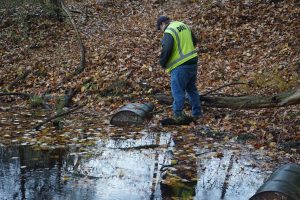
DEQ geologist investigates steel drums for potential PFAS contamination, Photo by michigan.gov via flickr cc 2.0
Governor Snyder’s Deputy Press Secretary Tanya Baker tells Great Lakes Now, “The state is conducting a statewide study of PFAS levels in groundwater, which is believed to be the first of its kind in the nation that is this widespread and robust. Proactive public water supply testing for all water systems, regardless of size, is expected to be completed by December 2018, including 1,380 municipal water systems and 461 schools. To date, about half of the municipal tests have been completed and Parchment was the first system to show a high level of PFAS. The testing in Kalamazoo County was conducted as part of Governor Rick Snyder’s unprecedented and proactive effort to test all water systems for these chemicals, which are starting to emerge in many states across the nation and raising public health concerns.”
Baker adds, “Due to the ongoing health and safety concerns as a result of the PFAS contamination in the drinking water for the City of Parchment and Cooper Township, Lt. Gov. Brian Calley declared a state of emergency on Sunday, making available all state resources in cooperation with local response and recovery operations. The declaration authorizes the Michigan State Police, Emergency Management and Homeland Security Division to coordinate state efforts.”
The state won’t say anything about the source of what caused the high levels of PFAS, and says it’s still under investigation.
Some Parchment and Cooper Township residents say they’re angry, and say they’ve known for a long time there’s something wrong with the water in their community. They say they suspect the source of the PFAS is the old papermill which has been abandoned since 2001. The town is named after the Kalamazoo Vegetable Parchment company which opened its doors in 1909 and once manufactured products there. Parchment was even nicknamed “The Paper City.”
PFAS: the “Forever Chemical”
Communications Director with the Michigan League of Conservation Voters Katie Parrish tells Great Lakes Now the state has not done enough to investigate PFAS across the state and hasn’t kept residents informed of the danger.
Parrish says, “The state of emergency in Parchment should sound alarm bells for state leaders to take bold action immediately. PFAS pollution has now grown from 32 publicly-released sites to now maybe 11,000 or more. Citizens deserve to know immediately if there is PFAS in their water so they can take steps to protect themselves and their families. We again reiterate our call for lawmakers to return to Lansing from summer break to enact an enforceable drinking water standard and to launch a full investigation into this “forever chemical” crisis in our water and how an MDEQ report exposing it six years ago was ignored, kept from the public and swept under the rug.”
Anthony Spaniola, a Troy, Michigan attorney, PFAS activist and member of the “Need Our Water” community action group in Oscoda, where he owns property in the zone of concern for PFAS contamination, also claims the state of Michigan hid information from the public that could have prevented Kalamazoo County’s State of Emergency from occurring.
Spaniola tells Great Lakes Now, “Nearly six years ago, in a report that was hidden from the public, a DEQ scientist warned top State officials of a PFAS water and public health crisis impacting every corner of Michigan. This week, after a PFAS water emergency was declared in west Michigan, and PFAS was discovered pouring into Lake St. Clair, we have learned of yet another suppressed report identifying over 11,000 potential PFAS sites throughout Michigan. Unfortunately, top State officials have also chosen to mislead the public by relying on an already discredited PFAS water advisory from the EPA, which the Harvard School of Public Health has found to be 70 times too high. The PFAS crisis impacts all of us everywhere in Michigan. Our top State officials, as in Flint, have once again failed to protect the public.”
MDEQ spokesperson Scott Dean strongly disagrees with Spaniola and Parrish’s assessment of the state’s response to PFAS contamination.
He tells Great Lakes Now, “No other state in the union has done more to root out PFAS contamination and protect the public than Michigan. In Michigan, we didn’t wait for an action level to be determined by the EPA. We set our own to go after polluters while encouraging the EPA to establish a national standard.”
Dean says the Parchment and Cooper Township PFAS drinking water contamination sites are the only known municipal PFAS drinking water contamination sites in the state right now, and the state’s own investigation uncovered it.
Dean says, “The Parchment result is a result of the state-wide study of PFAS levels in groundwater. The $1.7 million survey of PFAS in groundwater is believed to be the first of its kind in the nation. 75% of Michigan’s population is on a public drinking water supply. Proactive public water supply testing will be complete by December 2018.
Dean says more contaminated municipal water supplies could be uncovered in the future. He says, “We are roughly half way through the testing program and this is the first result over the EPA Health Advisory level of 70 ppt that we have recorded.”
More than 11,000 potential PFAS-contaminated sites in Michigan
The MDEQ’s Scott Dean says the newly released report of more than 11,000 sites that could be contaminated by PFAS is being misinterpreted. He says, “The list of 11,300 potential sites mapped out by DEQ are not sites of contaminated water, but a list of places to look for PFAS-containing materials or waste. This list guided DEQ in developing the testing schedule for the state’s 1,380 public water systems.”
Dean tells Great Lakes Now, “There continues to be a robust scientific – and even political — debate about PFAS. Most states are taking a wait-and-see approach. Here in Michigan, we’re committed to working together to root out this contaminant, protect all our residents, drive down exposure levels and make polluters pay. No state has moved faster on all aspects of the response to this emerging contaminant.”
Featured Image: PFAS water sample from theBelmont and Rockford areas, Photo by wgvunews.org
Two days before the State of Emergency declaration, Kalamazoo County issued a warning after the PFAS contamination was revealed. Here it is:
City of Parchment and Cooper Township Residents Advised to Immediately Stop Using Water.
The Kalamazoo County Health & Community Services Department in unison with the Michigan Department of Health & Human Services, Michigan Department of Environmental Quality, the City of Parchment, and Cooper Township is advising any resident on the City of Parchment’s water supply system to immediately stop using their water for drinking, cooking, making baby formula and food, or rinsing fruits and vegetables. High amounts of the chemical PFAS have been found in the water supply of City of Parchment.
Perfluoroalkyl and polyfluoroalkyl substances (PFAS), such as perfluorooctanoic acid (PFOA) and perfluorooctanesulfonic acid (PFOS), are part of a group of chemicals used globally during the past century in manufacturing, firefighting and thousands of common household and other consumer products.
Boiling water will not remove PFAS. Common residential filters do not treat PFAS. Swallowing PFAS is the primary way it can get into your body. Touching the water is not considered a health concern as PFAS does not move easily through skin. You can bathe, do your dishes, launder your clothes and clean with water that has PFAS in it. It is advised that farm animals and pets do not drink the water.
Bottled water will be provided to you starting Friday, July 27, at Parchment High School (1916 E. G Ave.) at 7:00 a.m. to 8:00 p.m.
We ask for residents on the City of Parchment’s water supply, which includes Cooper Township, to help spread this message to your neighbors.
A short-term solution is being activated within the next 24-48 hours:
- The City of Parchment’s water supply system is being drained.
- Once it is drained, the City of Kalamazoo will connect residents on the City of Parchment’s water supply to the City of Kalamazoo’s water supply system. Residents will be notified once this occurs.
- The City of Kalamazoo will begin flushing the City of Parchment’s water supply system.
- The City of Kalamazoo will continue flushing out the City of Parchment’s water supply system until test results come back that shows the PFAS levels are below the health advisory level. We do not know how long this process will take, but residents will not be connected back to the City of Parchment’s water supply until it is approved.
For more information, call 269-567-7595 or 269-567-2517. Resident can learn more about PFAS, please visit the website of Michigan PFAS Action Response Team (MPART): www.michigan.gov/pfasresponse/.


